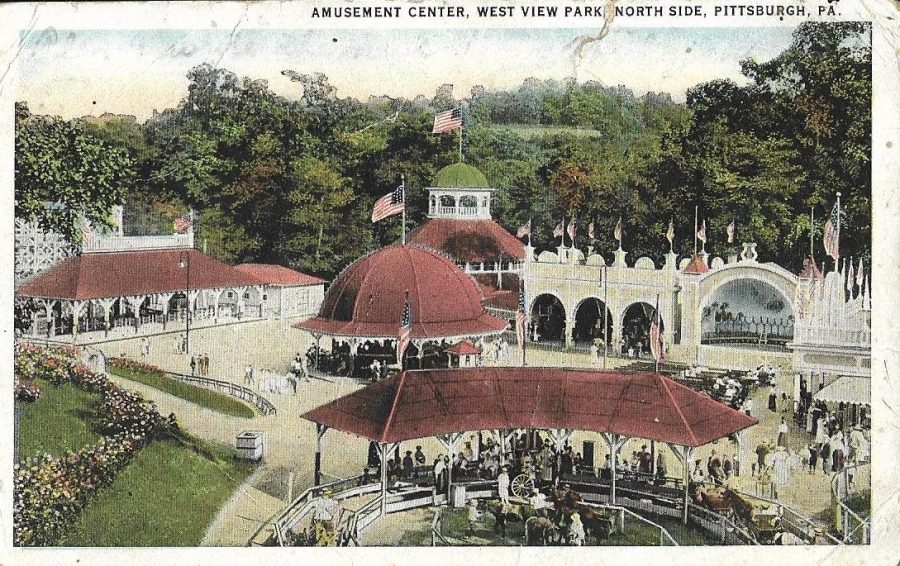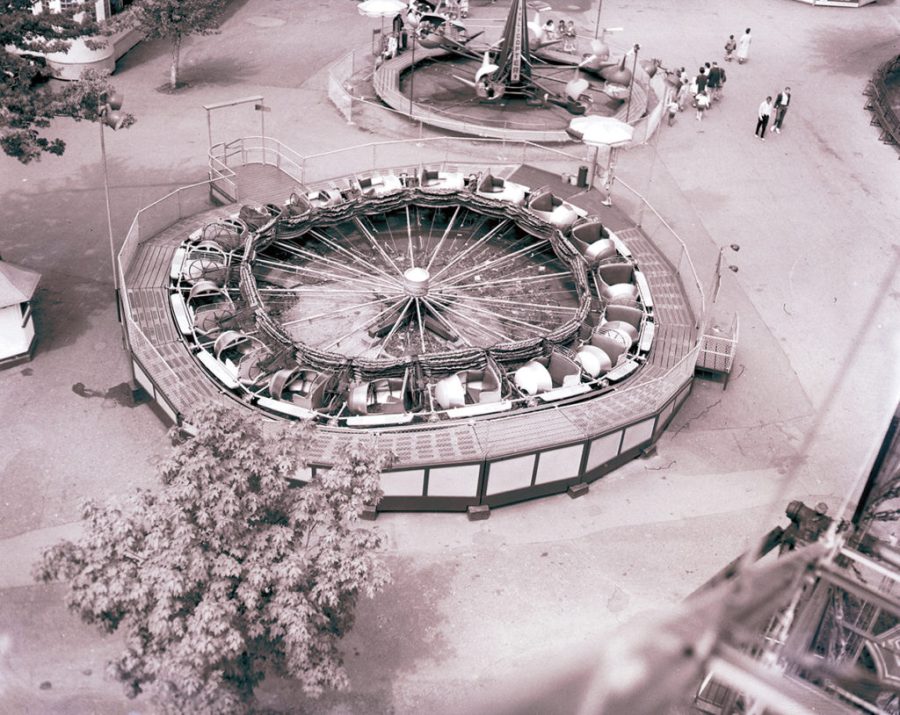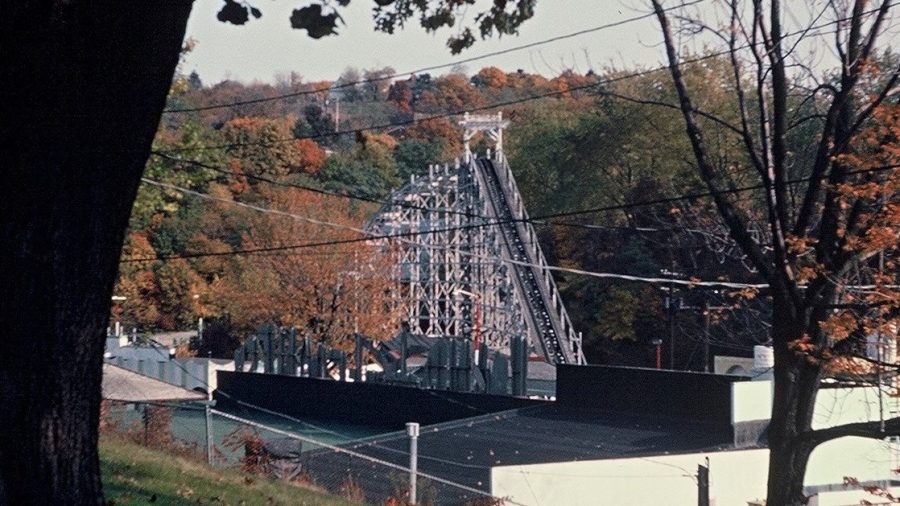Remembering West View Park
45 years after closing for good, the North Hills amusement park is fondly remembered by those who visited it.
A photograph taken of the Dips roller coaster in the twilight years of West View Park
Before Interstate 279, Perry Highway was the main road north of Pittsburgh. Winding up and down hills as it leaves the North Side, the road soon enters the borough of West View, where it passes the West Park Shopping Center. Today, this section of Perry Highway is little more than a backroad, but for years, it was the trolley line that brought thousands of visitors daily to a major amusement park.
West View Park closed for good in 1977, but the shopping center still bears the park’s name, its sign topped with a carousel horse—serving as a visible reminder of a once-legendary Pittsburgh amusement park.
When West View Park opened in 1906, it was advertised as an escape from the smog and smoke of downtown Pittsburgh. At the time, it was one of seven amusement parks in the Pittsburgh area, but only West View and Kennywood found long-term prosperity.

Attractions during those first few years were modest, but before World War I, people didn’t come to amusement parks for the rides. Although there was an Old Mill ride and a side-friction roller coaster, the most popular attractions were group picnics, boating on the lake, and especially dancing.
Known as Danceland, the dance hall would ultimately burn to the ground in 1973 after being one of West View’s greatest draws for decades. However, Cheryll Geisler, a former resident of West View, retains fond memories of the old dance hall.
“My parents met at Danceland right before my dad was drafted, and they were married for 63 years,” Geisler told The Uproar.
West View Park was the source of countless romances over the decades, but as the park grew, amusement rides–and especially roller coasters–became more important to its success. In 1911, the park opened its most famous attraction, the Dips. This simply-named coaster would be upgraded in 1929, but with its steep drops and thrilling swoop turn just feet off of Perry Highway, it remained West View’s most popular ride until the park’s end.

With the popularity of the Dips, West View Park soon opened another major roller coaster, the dual-tracked Racing Whippet. The Whippet was one of two large racing coasters that opened in Pittsburgh that year, as Kennywood also opened the Racer in 1927.
Ingrained into the natural topography at the back of the park, the Racing Whippet is fondly remembered by West View Park patron Rick O’Leary.
“One Saturday in 1970, my cousin and I rode the Racing Whippet over and over for the whole day — many, many hours in a row. We didn’t ride another ride all day,” O’Leary recalled.
Some of my own family members even have memories of West View Park, as it was home to my grandfather’s ironworkers’ picnic until closing n 1977. My dad was just entering elementary school that year, but even today, he still remembers seeing the huge bat on the front of the Haunted House and riding the Caterpillar ride with his mother; similar to a Music Express ride, a Caterpillar is unique for the canvas canopy that encloses its circle of riders in darkness.
The facade of the Haunted House in Ocean City, Maryland is similar to that of West View Park’s Haunted House, which itself was moved to an Ohio amusement park following West View’s closure.
West View Park is responsible for countless fond memories among Pittsburgh area residents, but it also served as a memorable first job for many local teenagers–including Ellen Aschenbrenner, who vividly remembers working the Fish Pond game.
“When I started working there, I was so thirsty one day that I took a drink of water from the Fish Pond trough. It was only after I swallowed a mouthful that I realized how many hands had been in the water that I had just drank,” Aschenbrenner said.
Surprisingly, 45 years after its closure, interest in the history of West View Park continues to grow. This past December, a new book was published on the park’s history, and the West View Historical Society is currently trying to raise funds for a museum that will feature the history of West View Park.
While it can be hard to believe that the North Hills was once home to a major amusement park, the West View Park Shopping Center leaves no question about the park’s existence. Even so, some do not realize the impact it had on the West View community and the lives of countless Pittsburghers. Couples met at Danceland to see the latest bands, it was a popular place for annual family gatherings, and for many children, the school picnic at West View Park was the highlight of the year.
An auto repair shop now stands at the former site of the Dips’ dynamic turnaround.
Today, West View Park remains a rallying point to the West View community. Remembering the park keeps fond memories of the past alive for many, and for those who never visited, preserving the memory of the park gives a glimpse into a different era of Pittsburgh’s North Hills. Even though the thrills of the Dips are lost to time, it is unlikely that the importance of West View Park will ever be forgotten.

Years after editing and delivering the Carson Middle newspaper by himself, Andrew McLaughlin is excited to be Co-Editor-in-Chief of The Uproar. Always a fan of amusement park history, he has written for the magazine of the National Amusement Park Historical Association. He also volunteers at the Depreciation Lands Museum, a local living history museum. Andrew welcomes comments about his writing.


Don Woodrow • Oct 15, 2023 at 6:00 pm
We had school picnics at West View as a child in Emsworth. We took the street car to Bellevue, changed cars there and then to West View…later, back to Emsworth the same way, I never rode in the Caterpillar,…it scared me but the Dips were great. All of it for less than $2 earned on my Sun-Tele paper route.
A.T. Schmalzried - nyc,ny • Sep 28, 2022 at 2:23 pm
…brookline school/community picnics; ..attended them from 1954-77!
Few holiday events matched the energy/excitement of wvp on ‘picnic’ day.
The demolition of the park was unforgivable, …but, ..oh, the memories!
Brenda • Aug 10, 2022 at 9:07 pm
My dad worked at McGraw-Edison in the 1970s, and for at least a couple of years I remember going to West View for his company picnic. Those visits are etched in my memory as fun fun fun! Davy Jones Locker and the Haunted House are most memorable. Sad to see it close in 1977. We went to White Swan Park that year. Not fun at all.
I just finished watching The Amusement Park by George Romero. Interesting to see the park while it was still open.
Ed Zahn • Jul 30, 2022 at 1:14 pm
The summer of 1963 I worked at West View Park at the Haunted House. The pay was minimal. There were some real characters as park employees. Artie was one of the little people working at the children’s fish pond. In a foot race Artie was unbeatable in a 40 yard dash. Working at the park was a study of our society. The nicest picnic of the year was held by the Carpender’s union. The families were very polite, pleasant and well mannered. There were other nice picnics and some not so nice.
Ed Z. From Ingomar
Beth • Apr 22, 2025 at 3:39 pm
My Grandfather was in the Carpenter’s Union and my Dad recalls MANY Carpenter’s Picnics held at WVP. My Grandpa was a big Sicilian man, with huge hands… my Dad’s best picnic memory was him walking away from the ticket booth with both hands filled with tickets for him and his two sisters (my aunts) so they could spend the day riding while he and my Nana relaxed at Danceland. They’ve all passed on, including my Dad… but I’m glad stories like this remain on the internet. 🙂
Beth Pedone
Jan • Jul 11, 2022 at 2:11 pm
Shared with my dad, a West View native and current nursing home resident. Thank you!
Mary Anne Ireland • Aug 16, 2024 at 11:23 pm
I remember being at Holy Family School in Lawrencville. A streetcar was chartered to pick us up and took us to Westview Park. Mothers came along with picnic lunches . Then by 6:00 my dad would come to the park and joined us for the rest of the evening and finally take us home.
The wooden roller coasters were the best. I remember the Penny Arcade where you could get pictures of stars and a special machine that made a round coin that you printed your name on. Many great memories. I would have liked to take my children there to share the same memories.